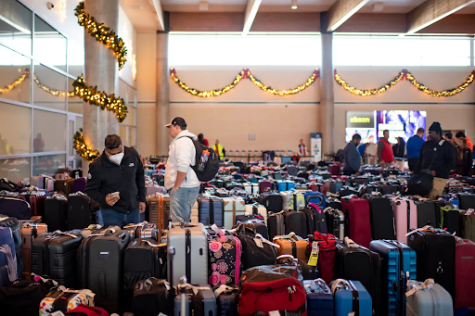This Winter’s Flight Cancellation Crisis

Photo courtesy of CNN.
February 1, 2023
The December period of holidays is among the busiest times of the year for airline and travel companies. Thousands of families travel into, out of, and around the United States. While typically a positive thing, the busyness of these companies during this time of year can lead to chaos. This winter, nearly all major airline companies were hit with thousands of canceled or delayed flights, leaving many customers outraged and misplaced.
The airline industry’s crisis led to thousands of questions from the public, but one remained the most prevalent: how could such a large-scale issue occur?

(Emil Lippe)
System Outages
According to the Federal Aviation Administration (FAA), which is in charge of the safety of those flying in the United States, there was a major system outage from a large winter storm that occurred near the end of December. The administration explained that as soon as they realized they had widespread computer and technological issues, they halted as many flights as possible and rebooted their entire system as quickly as they could. This solution was widely accepted by customers of companies that were able to restart shortly after the reboot such as American Airlines or United Airlines. However, one airline took a lot longer to get going again.
Southwest’s Holiday Crisis
While Delta Airlines, United Airlines, and American Airlines each canceled less than 40 flights on December 28, 2022, Southwest Airlines canceled around 2,500. Southwest, which took about a week longer than its competitors to smoothly run once again, is one of the most popular airlines in the country, known for its low prices and free checked luggage.
The major difference between Southwest and its competitors, and the factor that likely led to the crisis it experienced, is its “point-to-point” route model. This model allows passengers to travel from big cities to smaller areas without having to stop at large metro airports. This cuts down on travel times and benefits travelers heading to or from smaller cities. Other airlines, such as American Airlines, use a different model commonly referred to as the “hub-and-spoke” model. Passengers coming from smaller areas typically have to fly to a nearby major airport and change planes in order to fly to a different major airport. The latter model makes it easier for planes to remain close to their home airports and allows for more convenient regrouping. The former creates a problem when a shutdown happens, for planes and crews are scattered around the country and sometimes cannot make it back to where they belong. This, along with the system outages at the FAA, is exactly what happened to Southwest this past December.
This issue is bleeding into the new year. The Southwest Airlines Pilots Association, which is the union representing all Southwest pilots, claims that it has been pleading with the company to switch its methods to align with those of airlines such as American and Delta. On January 21, 2022, the union announced a strike authorization vote that will begin on May 1. Throughout the outages and cancellations last December, thousands of pilots and flight crews had nowhere to go. Many stated they had to sleep in airports near luggage, which was just one grievance out of the numerous that the union had. This winter has been catastrophic for Southwest, but as of January 3, the airline announced that their company is back to normal. While the possible strike still looms and winter storm season has yet to end, Southwest, along with its customers, will hope that operations remain running smoothly,









